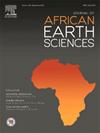The influence of the Nile water system on groundwater recharge and discharge at Khartoum City- Central Sudan
IF 2.2
4区 地球科学
Q2 GEOSCIENCES, MULTIDISCIPLINARY
引用次数: 0
Abstract
The study area lies at the confluence of the Blue and White Niles in Khartoum, the capital of Sudan. The main objective of the current study is to assess the influence of the Niles water system on groundwater recharge and discharge. Three methods of investigations were applied; base-flow Recession Method, Water Levels Fluctuations (WLF) and the Darcy Method. The amount of water discharge of the Niles varies seasonally; the highest flows were registered in the autumn seasons. The amount of 816 × 106m3/day was registered in 1988 as maximum discharge and 49 × 106m3/day in 1984 as minimum one in Soba Station on the Blue Nile. Groundwater is mainly stored in two aquifers, Gezira and Sandstone formations, both aquifers are hydraulically interconnected to form one aquifer system. Gezira formation represents the saturated upper zone that let it in direct contact with Niles waters. The hydraulic gradients range from ≥0.005 to ≤0.002 from west to the east direction; indicating that, the White Nile is the main source of recharge for groundwater rather than the Blue Nile. Using the Darcy method, the groundwater recharge from the While Nile is more than twice the recharge from the Blue Nile. In general the groundwater recharge from the River Niles using the three methods is estimated at about 130 × 106 m3 annually. The strong interface between the Niles surface water and groundwater in the Khartoum area will raises concerns on Niles waters contamination with already polluted shallow groundwater aquifers.
求助全文
约1分钟内获得全文
求助全文
来源期刊

Journal of African Earth Sciences
地学-地球科学综合
CiteScore
4.70
自引率
4.30%
发文量
240
审稿时长
12 months
期刊介绍:
The Journal of African Earth Sciences sees itself as the prime geological journal for all aspects of the Earth Sciences about the African plate. Papers dealing with peripheral areas are welcome if they demonstrate a tight link with Africa.
The Journal publishes high quality, peer-reviewed scientific papers. It is devoted primarily to research papers but short communications relating to new developments of broad interest, reviews and book reviews will also be considered. Papers must have international appeal and should present work of more regional than local significance and dealing with well identified and justified scientific questions. Specialised technical papers, analytical or exploration reports must be avoided. Papers on applied geology should preferably be linked to such core disciplines and must be addressed to a more general geoscientific audience.
 求助内容:
求助内容: 应助结果提醒方式:
应助结果提醒方式:


